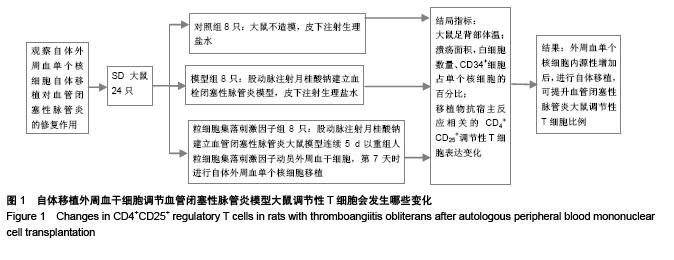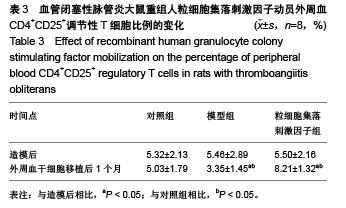| [1] 王会梅,高荣芳,吕金波.中西医结合治疗下肢动脉硬化性闭塞症65例[J].中国中西医结合外科杂志,2007,13(4):398.
[2] Latza U, Stang A, Bergmann M, et al. The problem of response in epidemiological studies in Germany (part I). Gesundheitswesen. 2004;66(5):326-336.
[3] Ruiz-Salmeron R, de la Cuesta-Diaz A, Constantino-Bermejo M, et al. Angiographic demonstration of neoangiogenesis after intra-arterial infusion of autologous bone marrow mononuclear cells in diabetic patients with critical limb ischemia. Cell Transplant. 2011;20(10):1629-1639.
[4] Lasala GP, Minguell JJ. Vascular disease and stem cell therapies. Br Med Bull. 2011;98:187-197.
[5] Idei N, Soga J, Hata T, et al. Autologous bone-marrow mononuclear cell implantation reduces long-term major amputation risk in patients with critical limb ischemia: a comparison of atherosclerotic peripheral arterial disease and Buerger disease. Circ Cardiovasc Interv. 2011;4(1):15-25.
[6] Matsumura G, Miyagawa-Tomita S, Shin'oka T, et al. First evidence that bone marrow cells contribute to the construction of tissue-engineered vascular autografts in vivo. Circulation. 2003;108(14):1729-1734.
[7] Simper D, Stalboerger PG, Panetta CJ, et al. Smooth muscle progenitor cells in human blood. Circulation. 2002;106(10): 1199-1204.
[8] Lin Y, Weisdorf DJ, Solovey A, et al. Origins of circulating endothelial cells and endothelial outgrowth from blood. J Clin Invest. 2000;105(1):71-77.
[9] Yoon YS, Wecker A, Heyd L, et al. Clonally expanded novel multipotent stem cells from human bone marrow regenerate myocardium after myocardial infarction. J Clin Invest. 2005; 115(2):326-338.
[10] Yamashita J, Itoh H, Hirashima M, et al. Flk1-positive cells derived from embryonic stem cells serve as vascular progenitors. Nature. 2000;408(6808):92-96.
[11] Miranville A, Heeschen C, Sengenès C, et al. Improvement of postnatal neovascularization by human adipose tissue-derived stem cells. Circulation. 2004;110(3):349-355.
[12] 宫立众,夏顺中.外周血干细胞移植研究进展[J].重庆医学,2002, 31(5):430-432.
[13] 李施施,刘忠,严庆丰.外周血细胞重编程为诱导性多潜能干细胞的研究进展[J].中国细胞生物学学报,2011,(8):930-935.
[14] 吴德沛,唐晓文,夏学鸣.自体外周血干细胞移植并发Ⅳ度移植物抗宿主病一例[J].中华血液学杂志,2000,21(8):423-424.
[15] Sakaguchi S, Sakaguchi N, Asano M, et al. Immunologic self-tolerance maintained by activated T cells expressing IL-2 receptor alpha-chains (CD25). Breakdown of a single mechanism of self-tolerance causes various autoimmune diseases. J Immunol. 1995;155(3):1151-1164.
[16] Shevach EM. Certified professionals: CD4(+)CD25(+) suppressor T cells. J Exp Med. 2001;193(11):F41-46.
[17] Annacker O, Pimenta-Araujo R, Burlen-Defranoux O, et al. CD25+CD4+ T cells regulate the expansion of peripheral CD4 T cells through the production of IL-10. J Immunol. 2001; 166(5):3008-3018.
[18] Field EH, Matesic D, Rigby S, et al. CD4+CD25+ regulatory cells in acquired MHC tolerance. Immunol Rev. 2001;182: 99-112.
[19] Cohen JL, Trenado A, Vasey D, et al. CD4(+)CD25(+) immunoregulatory T Cells: new therapeutics for graft-versus-host disease. J Exp Med. 2002;196(3):401-406.
[20] Hoffmann P, Ermann J, Edinger M, et al. Donor-type CD4(+)CD25(+) regulatory T cells suppress lethal acute graft-versus-host disease after allogeneic bone marrow transplantation. J Exp Med. 2002;196(3):389-399.
[21] Edinger M, Hoffmann P, Ermann J, et al. CD4+CD25+ regulatory T cells preserve graft-versus-tumor activity while inhibiting graft-versus-host disease after bone marrow transplantation. Nat Med. 2003;9(9):1144-1150.
[22] 中华人民共和国科学技术部.关于善待实验动物的指导性意见. 2006-09-30.
[23] 孙晓春,蔡花,吴乐乐,等.G-CSF动员大鼠外周血间质干细胞的初步实验研究[J].中国细胞生物学学报,2010,(5):762-765.
[24] 杨镛,杨国凯,何晓明,等.经皮透光负压旋切术治疗下肢静脉性皮肤溃疡的疗效与评价[J].中国普外基础与临床杂志,2009, 16(12): 996-999.
[25] 李学锋,沈振亚,谷涌泉,等.自体骨髓干细胞移植治疗血栓闭塞性脉管炎[J].中国普外基础与临床杂志,2010,17(7):656-659.
[26] 李国剑,杨镛,杨国凯,等.自体外周血干细胞移植治疗血栓闭塞性脉管炎的临床应用[J].中国普外基础与临床杂志,2012,19(11): 1187-1190.
[27] 虞希祥,朱国庆,郝伟远.自体骨髓干细胞移植治疗下肢严重缺血的临床研究[J].医学影像学杂志,2010,20(8):1165-1167.
[28] 孙文,郁涂巍,梁健.自体骨髓干细胞移植治疗下肢动脉硬化闭塞症11例报告[J].中国医师进修杂志,2006,29(32):62,68.
[29] Tateishi-Yuyama E, Matsubara H, Murohara T, et al. Therapeutic angiogenesis for patients with limb ischaemia by autologous transplantation of bone-marrow cells: a pilot study and a randomised controlled trial. Lancet. 2002;360(9331):427-435.
[30] 杨镛,陆平,何晓明,等.人自体干细胞移植在重症肢体缺血血流重建中的疗效与评价[J].中国普外基础与临床杂志,2009,16(2): 115-118.
[31] 缪健航,师天雄,胡锡祥,等.自体外周血干细胞移植治疗下肢动脉缺血性疾病的临床应用[J].中国普外基础与临床杂志,2008, 15(2):106-108.
[32] Matoba S, Tatsumi T, Murohara T, et al. Long-term clinical outcome after intramuscular implantation of bone marrow mononuclear cells (Therapeutic Angiogenesis by Cell Transplantation [TACT] trial) in patients with chronic limb ischemia. Am Heart J. 2008;156(5):1010-1018.
[33] 杨继武,周业庭,刘伟平,等.重组人肝细胞生长因子联合粒细胞集落刺激因子对血管新生的影响[J].中华实验外科杂志,2010, 27(6): 842.
[34] Yamamoto K, Kondo T, Suzuki S, et al. Molecular evaluation of endothelial progenitor cells in patients with ischemic limbs: therapeutic effect by stem cell transplantation. Arterioscler Thromb Vasc Biol. 2004;24(12):e192-196.
[35] Lee HC, An SG, Lee HW, et al. Safety and effect of adipose tissue-derived stem cell implantation in patients with critical limb ischemia: a pilot study. Circ J. 2012;76(7):1750-1760.
[36] Bura A, Planat-Benard V, Bourin P, et al. Phase I trial: the use of autologous cultured adipose-derived stroma/stem cells to treat patients with non-revascularizable critical limb ischemia. Cytotherapy. 2014;16(2):245-257.
[37] Zhi K, Gao Z, Bai J, et al. Application of adipose-derived stem cells in critical limb ischemia. Front Biosci (Landmark Ed). 2014;19:768-776.
[38] Cai A, Qiu R, Li L, et al. Atorvastatin treatment of rats with ischemia-reperfusion injury improves adipose-derived mesenchymal stem cell migration and survival via the SDF-1α/CXCR-4 axis. PLoS One. 2013;8(12):e79100.
[39] Acosta L, Hmadcha A, Escacena N, et al. Adipose mesenchymal stromal cells isolated from type 2 diabetic patients display reduced fibrinolytic activity. Diabetes. 2013; 62(12):4266-4269.
[40] Moazzami K, Majdzadeh R, Nedjat S. Local intramuscular transplantation of autologous mononuclear cells for critical lower limb ischaemia. Cochrane Database Syst Rev. 2011; (12):CD008347.
[41] Benoit E, O'Donnell TF, Patel AN. Safety and efficacy of autologous cell therapy in critical limb ischemia: a systematic review. Cell Transplant. 2013;22(3):545-562.
[42] Teraa M, Sprengers RW, van der Graaf Y, et al. Autologous bone marrow-derived cell therapy in patients with critical limb ischemia: a meta-analysis of randomized controlled clinical trials. Ann Surg. 2013;258(6):922-929.
[43] von Boehmer H. Mechanisms of suppression by suppressor T cells. Nat Immunol. 2005;6(4):338-344.
[44] Taylor PA, Lees CJ, Blazar BR. The infusion of ex vivo activated and expanded CD4(+)CD25(+) immune regulatory cells inhibits graft-versus-host disease lethality. Blood. 2002; 99(10):3493-3499.
[45] Xia G, Kovochich M, Truitt RL, et al. Tracking ex vivo-expanded CD4+CD25+ and CD8+CD25+ regulatory T cells after infusion to prevent donor lymphocyte infusion-induced lethal acute graft-versus-host disease. Biol Blood Marrow Transplant. 2004;10(11):748-760.
[46] Joffre O, Gorsse N, Romagnoli P, et al. Induction of antigen-specific tolerance to bone marrow allografts with CD4+CD25+ T lymphocytes. Blood. 2004;103(11):4216-4221.
[47] Hanash AM, Levy RB. Donor CD4+CD25+ T cells promote engraftment and tolerance following MHC-mismatched hematopoietic cell transplantation. Blood. 2005;105(4): 1828-1836.
[48] Edinger M, Hoffmann P, Ermann J, et al. CD4+CD25+ regulatory T cells preserve graft-versus-tumor activity while inhibiting graft-versus-host disease after bone marrow transplantation. Nat Med. 2003;9(9):1144-1150.
[49] Trenado A, Charlotte F, Fisson S, et al. Recipient-type specific CD4+CD25+ regulatory T cells favor immune reconstitution and control graft-versus-host disease while maintaining graft-versus-leukemia. J Clin Invest. 2003;112(11):1688-1696.
[50] Zorn E, Kim HT, Lee SJ, et al. Reduced frequency of FOXP3+ CD4+CD25+ regulatory T cells in patients with chronic graft-versus-host disease. Blood. 2005;106(8):2903-2911.
[51] Gehrie EA, Booth GS. Stem cell collection considerations for AL amyloidosis. Conn Med. 2014;78(10):587-590.
[52] Flommersfeld S, Sohlbach K, Jaques G, et al. Collection of peripheral blood progenitor cells on Day 4 is feasible and effective while reducing granulocyte-colony-stimulating factor exposure to healthy donors. Transfusion. 2015;55(6): 1269-1274.
[53] Zhang WX, Zhao QY, Huang HQ. Febrile neutropenic infection occurred in cancer patients undergoing autologous peripheral blood stem cell transplantation. Transplant Proc. 2015;47(2):523-527.
[54] Pulsipher MA, Chitphakdithai P, Logan BR, et al. Lower risk for serious adverse events and no increased risk for cancer after PBSC vs BM donation. Blood. 2014;123(23):3655-3663.
[55] Eapen M, Logan BR, Horowitz MM, et al. Bone marrow or peripheral blood for reduced-intensity conditioning unrelated donor transplantation. J Clin Oncol. 2015;33(4):364-369.
[56] Hatsuse M, Fuchida S, Okano A, et al. Secondary MGUS following by adenovirus-induced hemorrhagic cystitis after autologous peripheral blood stem cell transplantation in a patient with multiple myeloma. Rinsho Ketsueki. 2014;55(11): 2277-2282. |


.jpg)
.jpg)
